- Full Name
- Putu Eka Guna Yasa
- Pen Name
- Putu Eka Guna Yasa
- Photograph by
- Link to Photograph
- Website for biography
- Place
- Denpasar
- Related Music
- Related Books
- Related Scholars Articles
Biography
In English
Putu Eka Guna Yasa was born on January 6, 1990 in Banjar Selat Tengah, Susut, Bangli. Completed his undergraduate education at the Balinese Literature Study Program, the Faculty of Cultural Sciences, Udayana University in 2012 and a master's degree in the Linguistics Masters Program with Pure Linguistic Concentration, Faculty of Cultural Sciences, Udayana University in 2017. He also attended the International Intensive Course in Old Javanese organized by the National Library in 2018 and 2019. Since 2013 he has worked as a staff at the Center for Lontar Studies at Udayana University. Actively writes articles in various media such as Bali Post, Post Bali, and Tribun Bali both in Balinese and Indonesian. A number of his articles were published in Prabhajnyana Book: The Study of Lontar Literature such as (1) The Meeting of Natural Beauty and the Beauty of Language in Kidung Dampati Lelangon; (2) Water Image in Ancient Javanese and Balinese Literary Library Temples; (3) Kidung Bhuwana Wisana: Aesthetic Heritage by Ida Padanda Ngurah; and (4) Sarira Devotees and Explorers. Gedong Kirtya published books about the world of Balinese literacy, including the Brata Term Dictionary in the Bali Lontar Library and the Synonym Dictionary in the Dasa Nama Lontar. Putu Eka Guna Yasa received an award as a Literacy Activist Youth from the Bali Language Center in 2018. Since that year, he has been appointed as a lecturer at the Balinese Literature Study Program, Faculty of Cultural Sciences, Unud. Since 2020 as executive director at the BASAbali Wiki foundation.
In Balinese
In Indonesian
Putu Eka Guna Yasa lahir pada tanggal 6 Januari 1990 di Banjar Selat Tengah, Susut, Bangli. Menyelesaikan pendidikan sarjana di Program Studi Sastra Bali Fakultas Ilmu Budaya Universitas Udayana pada tahun 2012 dan Magister Linguistik dengan Konsentrasi Linguistik Murni Fakultas Ilmu Budaya Universitas Udayana pada tahun 2017. Beliau juga mengikuti International Kursus Intensif Bahasa Jawa Kuna yang diselenggarakan oleh Perpustakaan Nasional RI pada tahun 2018 dan 2019. Sejak tahun 2013 bekerja sebagai staf di Pusat Studi Lontar Universitas Udayana. Aktif menulis artikel di berbagai media seperti Bali Post, Post Bali, dan Tribun Bali baik dalam bahasa Bali maupun bahasa Indonesia. Sejumlah artikelnya dimuat dalam Buku Prabhajnyana: Kajian Sastra Lontar seperti (1) Pertemuan Keindahan Alam dan Keindahan Bahasa di Kidung Dampati Lelangon; (2) Citra Air di Pura Perpustakaan Sastra Jawa Kuno dan Bali; (3) Kidung Bhuwana Wisana: Warisan Estetika oleh Ida Padanda Ngurah; dan (4) Penyembah dan Penjelajah Sarira. Gedong Kirtya menerbitkan buku-buku tentang dunia literasi Bali, antara lain Kamus Istilah Brata di Perpustakaan Lontar Bali dan Kamus Sinonim di Dasa Nama Lontar. Putu Eka Guna Yasa mendapat penghargaan sebagai Pemuda Aktivis Literasi dari Bali Language Center tahun 2018. Sejak tahun itu, ia diangkat sebagai dosen di Program Studi Sastra Bali, Fakultas Ilmu Budaya, Unud. Sejak tahun 2020 sebagai direktur eksekutif di yayasan BASAbali Wiki.
Examples of work
Wreastra script is a Balinese script which has 18 characters, namely Ha, Na, Ca, Ra, Ka, Da, Ta, Sa, Wa, La, Ma, Ga, Ba, Nga, Pa, Ja, Yes, and Nya. The Balinese script is different from the Javanese script when it comes to the number and shape. The development of the Balinese script cannot be separated from the story of Sang Aji Saka which developed in Java. This Baligraphic work on the Wreastra script is divided into seven works, namely Ha-Na, Ca-Ra-Ka, Ga-Ta, Ma-Nga-Ba, Sa-Wa-La, Pa-Da, and Ja-Ya-Nya which means there is a bodyguard who fights with his power. This large-sized calligraphy is made on canvas with a wooden frame placed at the Lontar Unit of Udayana University.
Wreastra script is a Balinese script which has 18 characters, namely Ha, Na, Ca, Ra, Ka, Da, Ta, Sa, Wa, La, Ma, Ga, Ba, Nga, Pa, Ja, Yes, and Nya. The Balinese script is different from the Javanese script when it comes to the number and shape. The development of the Balinese script cannot be separated from the story of Sang Aji Saka which developed in Java. This Baligraphic work on the Wreastra script is divided into seven works, namely Ha-Na, Ca-Ra-Ka, Ga-Ta, Ma-Nga-Ba, Sa-Wa-La, Pa-Da, and Ja-Ya-Nya which means there is a bodyguard who fights with his power. This large-sized calligraphy is made on canvas with a wooden frame placed at the Lontar Unit of Udayana University.
Wreastra script is a Balinese script which has 18 characters, namely Ha, Na, Ca, Ra, Ka, Da, Ta, Sa, Wa, La, Ma, Ga, Ba, Nga, Pa, Ja, Yes, and Nya. The Balinese script is different from the Javanese script when it comes to the number and shape. The development of the Balinese script cannot be separated from the story of Sang Aji Saka which developed in Java. This Baligraphic work on the Wreastra script is divided into seven works, namely Ha-Na, Ca-Ra-Ka, Ga-Ta, Ma-Nga-Ba, Sa-Wa-La, Pa-Da, and Ja-Ya-Nya which means there is a bodyguard who fights with his power. This large-sized calligraphy is made on canvas with a wooden frame placed at the Lontar Unit of Udayana University.
Wreastra script is a Balinese script which has 18 characters, namely Ha, Na, Ca, Ra, Ka, Da, Ta, Sa, Wa, La, Ma, Ga, Ba, Nga, Pa, Ja, Yes, and Nya. The Balinese script is different from the Javanese script when it comes to the number and shape. The development of the Balinese script cannot be separated from the story of Sang Aji Saka which developed in Java. This Baligraphic work on the Wreastra script is divided into seven works, namely Ha-Na, Ca-Ra-Ka, Ga-Ta, Ma-Nga-Ba, Sa-Wa-La, Pa-Da, and Ja-Ya-Nya which means there is a bodyguard who fights with his power. This large-sized calligraphy is made on canvas with a wooden frame placed at the Lontar Unit of Udayana University.
Wreastra script is a Balinese script which has 18 characters, namely Ha, Na, Ca, Ra, Ka, Da, Ta, Sa, Wa, La, Ma, Ga, Ba, Nga, Pa, Ja, Yes, and Nya. The Balinese script is different from the Javanese script when it comes to the number and shape. The development of the Balinese script cannot be separated from the story of Sang Aji Saka which developed in Java. This Baligraphic work on the Wreastra script is divided into seven works, namely Ha-Na, Ca-Ra-Ka, Ga-Ta, Ma-Nga-Ba, Sa-Wa-La, Pa-Da, and Ja-Ya-Nya which means there is a bodyguard who fights with his power. This large-sized calligraphy is made on canvas with a wooden frame placed at the Lontar Unit of Udayana University.
Wreastra script is a Balinese script which has 18 characters, namely Ha, Na, Ca, Ra, Ka, Da, Ta, Sa, Wa, La, Ma, Ga, Ba, Nga, Pa, Ja, Yes, and Nya. The Balinese script is different from the Javanese script when it comes to the number and shape. The development of the Balinese script cannot be separated from the story of Sang Aji Saka which developed in Java. This Baligraphic work on the Wreastra script is divided into seven works, namely Ha-Na, Ca-Ra-Ka, Ga-Ta, Ma-Nga-Ba, Sa-Wa-La, Pa-Da, and Ja-Ya-Nya which means there is a bodyguard who fights with his power. This large-sized calligraphy is made on canvas with a wooden frame placed at the Lontar Unit of Udayana University.
Wreastra script is a Balinese script which has 18 characters, namely Ha, Na, Ca, Ra, Ka, Da, Ta, Sa, Wa, La, Ma, Ga, Ba, Nga, Pa, Ja, Yes, and Nya. The Balinese script is different from the Javanese script when it comes to the number and shape. The development of the Balinese script cannot be separated from the story of Sang Aji Saka which developed in Java. This Baligraphic work on the Wreastra script is divided into seven works, namely Ha-Na, Ca-Ra-Ka, Ga-Ta, Ma-Nga-Ba, Sa-Wa-La, Pa-Da, and Ja-Ya-Nya which means there is a bodyguard who fights with his power. This large-sized calligraphy is made on canvas with a wooden frame placed at the Lontar Unit of Udayana University.
Dasaksara Hanoman Baligraphy consists of two forms, namely Kayonan and Hanoman. Dasaksara is described in Kayonan. The Dasaksara are the ten wijaksara that connect the human self (microcosm) and the universe (macrocosm). Dasaksara consists of ten wijaksara, namely Sang, Bang, Tang, Ang, Ing, Nang, Mang, Śing, Wang, Yang. The ten wijaksara come from the eight wianjana characters (sa, ba, ta, na, ma, si, wa, and ya) and two sound characters (a and i). If these ten wijaksara are strung together they form a sentence: sabatai nama siwaya which is a prayer to glorify Dewa Siwa. However, only a few Dasaksara are visible in the kayonan because they are covered by Hanoman's body. Wijaksara seen is Ong, Ang, Ung, Mang, Sang, Bang, miwah Tang.
Hanoman is a character in the epic Ramayana. Hanuman is the son of Dewi Anjani. Dewi Anjani is an angel who was cursed and born into the world as a female vanara. The curse ends when she gives birth to an incarnation of Siwa's son. Dewi Anjani is married to Kesari. Kesari and Dewi Anjani performed intense meditation to beget Dewa Siwa as their son. Because Kesari and Dewi Anjani were firm in their asceticism, Dewa Siwa granted their request and descended to earth as Hanoman.
If interpreted, Dasaksara Hanoman Baligraphy is a form of glorification of Dewa Siwa which is manifested in the figure of Hanoman.Translating is one of the pinnacles of IGB Sugriwa's skills which are now increasingly rare. Therefore, this article aimsto discuss two things,: (1) tracing the translated works produced by IGB Sugriwa; (2) the translation model developed by IGB Sugriwa in the Kakawin Rāmatantra. To achieve this goal, this article uses the methods of providing data, analyzing data, and presenting the results of the analysis. At the stage of providing data, observation and interview methods were used to find the translated works of IGB Sugriwa. Furthermore, IGB Sugriwa's translations were classified according to genre and Kakawin Rāmatantra was analyzed to find the translation model developed by IGB Sugriwa. Based on this analysis, this article finds that IGB Sugriwa has translated 13 literary works. Translated works are included in literature such as Kakawin Dharma Shunya (1954), Kakawin Sutasoma (1956), Bharata Yuddha (1958), Kakawin Ramayana (1960), Kakawin Arjuna Wiwaha (1961) and Kakawin Rāmatantra(t.t). Meanwhile, the translation works included in the speech are Sang Hyang Kamahayanikan (1957) and Sarasamuccaya (1967). Meanwhile, IGB Sugriwa was also quite productive in translating texts related to traditional Balinese historiography across clans such as the Babad Pasek (1957), Babad Blahbatuh (1958), Dwijendra Tattwa (1967), Babad Pasek Kayu Selem (tt), and the Pande Inscription. (tt). The translation model developed by IGB Sugriwa in the Kakawin Rāmatantrais formulated into four stages, namely (1) kosabasa (vocabulary); (2) kretabasa(grammar), (3) bhasita paribhasa (language style); and bhasita mandala (cultural context).
Mahakala is one of the manifestations of Dewa Siwa as the great destroyer. In Hindu mythology, Mahakala appears as a ferocious and frightening figure. In this baligraphy, Mahakala is shown in the form of Ong-kara as the center in which the dewata nawa sanga and sacred script are mentioned. The Dewata Nawa Sanga include Dewa Iswara, Dewa Brahma, Dewa Mahadewa, Dewa Wisnu, Dewa Siwa, Dewa Mahadewa, Dewa Rudra, Dewa Sangkara, and Dewa Sambu. The sacred script covering Ong-kara is the sacred symbol of Sang Hyang Widhi who embodies Dewa Siwa. Wijaksara Ang-kara as the sacred script of Dewa Wisnu. Apart from Ong-kara and Ang-kara there are also Vijaksara Bang as the sacred script of Dewa Brahma which is located in the south, Vijaksara Mang as the sacred script of Dewa Rudra which is located in the southwest, Vijaksara Tang as the sacred script of Dewa Mahadewa which is located in the west, and Wijaksara Śing the sacred script of Dewa Sangkara which is located in the northwest. What is very interesting in this baligraphy is the addition of a wall clock with Latin numerals in it.
So the relationship between Mahakala calligraphy and wall clocks: Mahakala is the embodiment of Dewa Siwa as the supreme god, as the ruler of time and all the elements in the universe (sakala and niskala).
IGB Sugriwa's Model of Translation in Kakawin Rāmatantra: The Effort to Continue the Springs Of Literature to Various Era



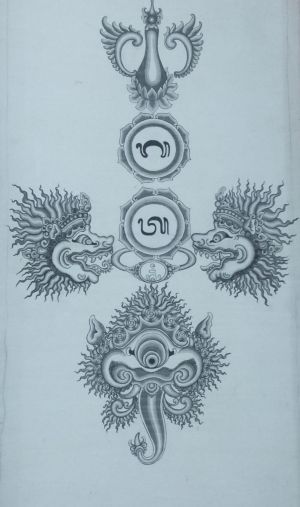



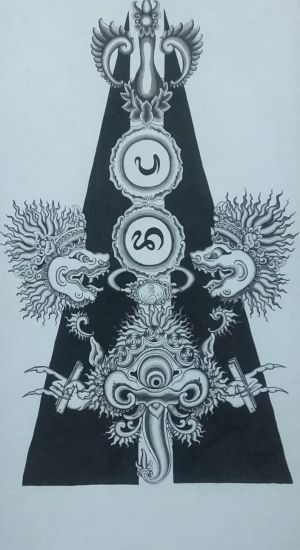
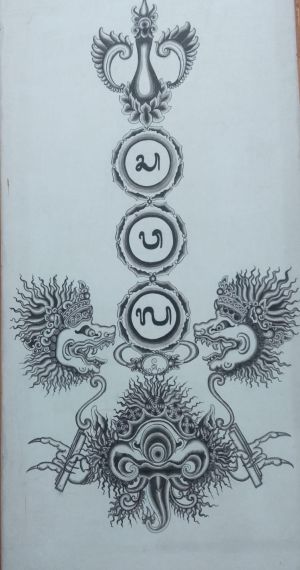
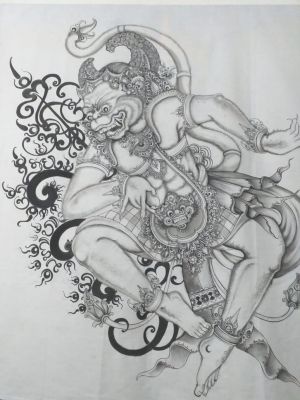

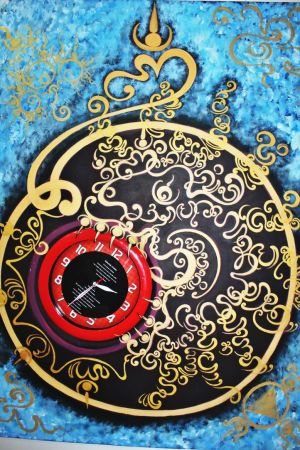






Enable comment auto-refresher